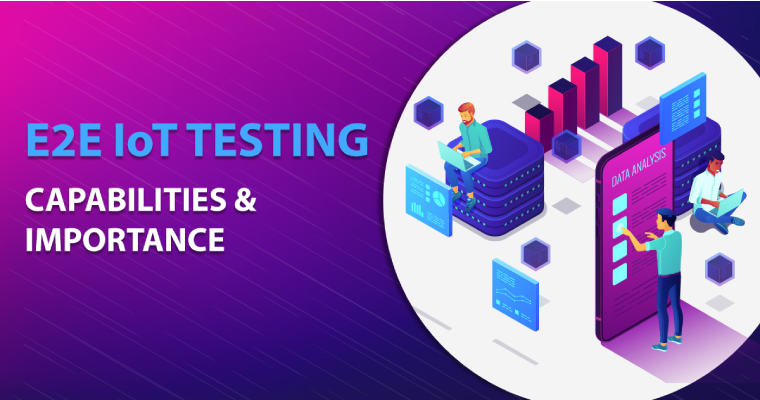

The Internet of things means taking the things in the world and connects them to the internet. In other words Internet of things is a network of devices, people, software, and data, working together for a smart functionality. The Internet of things extends internet connectivity beyond traditional devices to a wide range of devices and everyday things utilizing embedded technologies for communication and interaction with the external environment, via the Internet.
IoT testing is far more complicated compared to traditional software testing as IoT involves hardware, software, networks, and data. Managing each of these components of IoT has its own sets of difficulties. And, the interconnectivity of so many dissimilar components is an added challenge. Thus, end to end IoT testing is a huge responsibility.
End-to-end testing capability in IoT is challenging, however is mandatory for getting a functional IoT solution. If we concentrate on testing only certain components, no matter how perfectly those components are performing, the other parts of the system will act as weak links affecting the performance of the system as a whole.
Broadly, IoT has components such as application (web or mobile), cloud infrastructure, network, devices, sensors, etc. So, multistage validation involves end-to-end testing at the level of each component, and in the network.
Another challenge in multistage integration is about integrating third-party hardware, software, and systems. Furthermore, it also means validating the integration across different systems.
The end-to-end IoT testing involves testing of features and other critical key factors such as usability, data, and network security, scalability, performance, reliability, etc. Let’s see how testing of these areas affects an IoT system.
The biggest challenge in a system with so many dissimilar devices or software is about interoperability. For example, one technology and framework that works with certain devices, may not work for the others in the same system.
To exist as part of the same network, and work together, these devices have to be made interoperable. Moreover, it is important to integrate every device to other devices and facilitate inter device communication within the IoT network.
Some standards and protocols help in a seamless integration of IoT components for interoperability. Multistage validation helps to manage complex IoT development systems without worrying about about the interoperability of different types of devices and software.
IoT systems have large spans. More the devices, software, and bigger the network security becomes tough to achieve and maintain. There can be security threats at each end and even in the channels of communication.
So, to maintain security in an IoT environment, we must use secured frameworks and technologies in developing the network. As large volumes of data are involved, it is crucial to encrypt and store for making the data not vulnerable to damage or loss.
Data should also be encrypted during transmission or transfer in an IoT network as breaches can happen even over the channels.
IoT deployment connects multiple devices and software. Making such a complex system is costly and time-consuming. So, it is feasible only when it can benefit a large number of users. Thus, scalability is a major factor in the development of an IoT solution.
The way it is for any system, scalability comes with its own set of challenges. This includes but not limited to maintaining connectivity over a wide range and at relatively high speed so that the network doesn’t fail or underperform during operations.
More scattered the network, the higher will be the problems with scalability. Scalability testing is a crucial component of IoT testing.
Any system that doesn’t meet the performance requirements is not worth the time and resources used to build it. Since the resources required in a typical IoT engineering services solution deployment are high, performance is non-negotiable.
Performance is a broad term, and it includes everything that makes the system robust, functional, and fool-proof. Performance testing thus ensures that the IoT system keeps functioning as desired.
Performance testing includes load testing, connectivity testing, and checking whether the pace of different components matches for perfect real-time experience, etc.
Moreover, if the network is perfect, but a device fails, the system should be capable of isolating that device and alerting the authority or department responsible for maintaining that device. The system must still carry on with regular functions at other parts of the network.
Systems are becoming extremely user-centric. The user experience and usability determine the performance and value of an IoT system. Usability and user experience testing is critical.
IoT testing is a comprehensive task. It involves various sub-tasks at different sections of the IoT network. Without missing a single front, testing should be carried out at each level to make the system efficient and useful.
Multistage validation is important in IoT, as it is a huge network, and there is a possibility of failure at each end. Only the best IoT developers will take care of all your testing needs! Contact us now!
Jin Markov is a Content Writer with GoodFirms, a research firm in the USA. He loves reading about IoT while sipping his favorite cup of coffee.